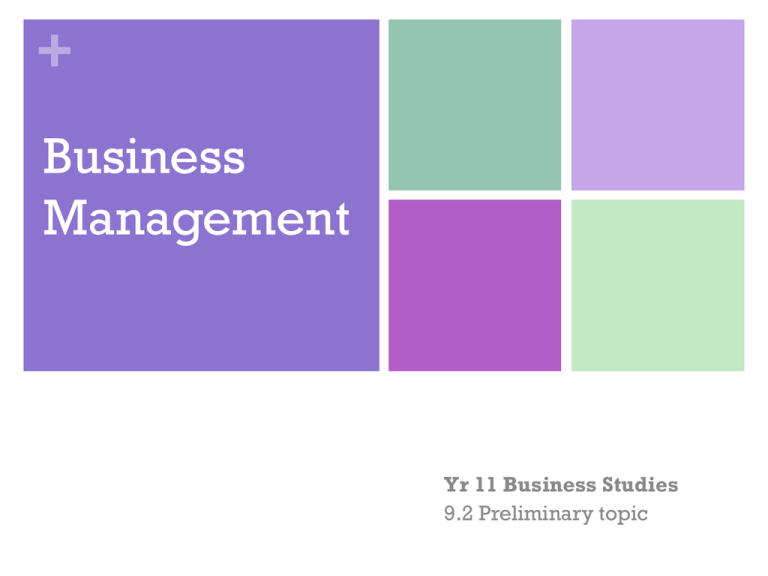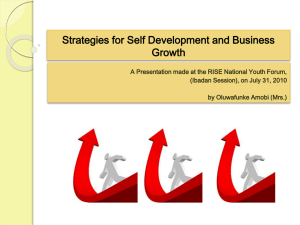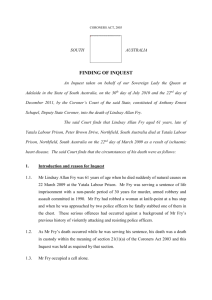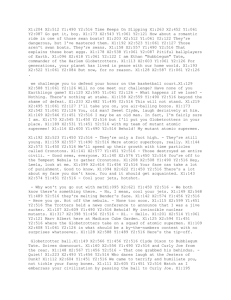yr_11_bus_studies_business_mgmt_130311
advertisement

+ Business Management Yr 11 Business Studies 9.2 Preliminary topic + Syllabus: You need to…… P2. explain the internal and external influences on businesses P4. assess the processes and interdependence of key business functions P5. examine the application of management theories and strategies P6. analyse the responsibilities of business to internal and external stakeholders P7. plan and conduct investigations into contemporary business issues P8. evaluate information for actual and hypothetical business situations P.9 communicate business information and issues in appropriate formats P.10 apply mathematical concepts appropriately in business situations Syllabus Specifics: Nature Of Management • Features features of effective management • Skills of management • interpersonal, • communication, • strategic thinking, • vision, • problem-solving, • decision-making, • flexibility, • adaptability to change, • reconciling the conflicting interests of stakeholders + Specifics cont. • Achieving business goals • profits, • market share, • growth, • share price, • social, • Environmental • achieving a mix of the above goals • staff involvement • innovation, • motivation, • mentoring, • training + Learn the Lingo See www.studyismybuddy.com New tab = 11 BUS Business Management Complete the Learn the Lingo Activity sheet + Topic To Discuss You will learn about 1. the nature of management 2. management approaches 3. the management process 4. management and change You will learn to examine contemporary business issues investigate aspects of business using hypothetical situations and actual business case studies + 1. The nature of management Ever been shopping and spent all your money on the first things you saw only to be disappointed when you came across something you would have liked more? OR Ever left your assessment task to the last minute only to find you didn’t have all your information resources or the internet was down? In these cases…..you did not manage either your money or time very well! These cases reveal that you have actually been practicing the art of management for a number of years! + Management vs Managers Activity Divide a blank page into 4 quadrants Label each quadrant one of the following • Good management • Poor management • Good Manager • Poor Manager • Write at least 5 words that best describes your understanding / experience for each of the quadrants. + What Is Management? Traditional definition: Is the process of coordinating a business’s resources to achieve its goals. Contemporary definition Is the process of working with and through other people to achieve the goals of the business in a rapidly changing environment. Crucial to this process is the effective and efficient use of limited resources. + What is a Manager? A manager is someone who coordinates the business’s limited resources in order to achieve specific goals. + The Contemporary Manager is … 1 5 2 4 3 + (a) Activity– “Business as Usual” In groups of 3, come up with a business Answer the following questions and present your information on 3-5 PowerPoint slides What is the business name? What do you sell/offer? (good or service) What is the size of your business (S,M,L) What industry (primary etc) are you in? Are you local, national or global? Why? What is its legal structure (eg sole trader etc)? Name ONE external factor that is impacting (good or bad) the business’s growth In your first year you make $500,000 in sales. What would be your next move for your business and why? Be as creative as you can! + 1.Working With And Through Others Management Those is a social process managers who DO NOT interact and communicate well with employees fail to achieve high levels of commitment from staff + 2. Getting The Most From Limited Resources - Efficiency All businesses face the problem of limited resources or scarcity. Managers therefore need to coordinate the resources more efficiently Efficiency compares the resources needed to achieve a goal (the costs) against what was actually achieved (the benefits) The most efficient coordination of resources occurs when the benefits are greater than the costs Remember………… Efficiency = benefits > costs + 3. Coping With A Rapidly Changing Environment This is ONE of the most important tasks of all managers Successful managers are those who anticipate and adjust to changing circumstances + 4.Balancing Efficiency And Effectiveness Managers must usually balance both the efficiency and effectiveness of their decisions. The key to achieving a competitive position in today’s challenging business environment is having the correct balance between efficiency and effectiveness + 5. Achieving The Goals Of The Business - Effectiveness Without goals, the business would quickly lose direction Employees would not understand the ultimate purpose of their work Managers would not be able to measure performance Effectiveness measures the degree to which a goal has been achieved + Effective Management = the ability of managers to achieve the business’s goals AND The goals of a business can only be achieved if manager’s have the right skills and expertise. + What Skills Do Managers Need To Operate Effectively? Interpersonal (people) Communication Strategic Thinking Vision Problem Solving and Decision making Flexibility and adaptability to change Reconciling the conflicting interests of stakeholders QLD Young Manager of the Year 2009: Barbara Miller http://www.youtube.com/watch?v=PayMHRBtyrg + Interpersonal Skills This is the ability to relate to people, being aware of and appreciating their needs and showing genuine understanding People skills include the ability to communicate, motivate, lead and inspire A manager who lacks empathy (understanding) is arrogant, opinionated, unable to communicate or who has difficulty relating to people will not be able to develop positive relationships with his/her employees. + Communication Skills Communication is one of the easiest and at the same time most difficult of management skills. Effective communication is the key – getting employees to understand and want to achieve the business’s goals. Managers who are effective communicators and who are able to share their thoughts and plans will find it easy to influence others. Communication can non verbal as well – a message that is not written or spoken. It mainly consists of body language such as posture, facial, expressions, placement of limbs and proximity to others. Managers need to be aware of the power of body language – it can contradict or it can truly indicate how an employee is feeling/thinking. + Strategic Thinking Skills Strategic thinking involves thinking about a business’s future direction and what future goals the business wants to achieve. Strategic thinking allows a manager to see the business as a whole and to take a broad, long term view. The ability to think strategically lets the manager see the ‘big picture’ which enables him/her to Visualise how work teams and individuals interrelate Understand the effect of any action on the business Gain insights into an uncertain future See the business in the contexts of events and trends, identify any opportunities and threats Managers at all levels need to exercise this skill. It can be learned through practice. An example of a lack of strategic thinking :‘Everything that could be invented has now been invented.’ U.S. Patent Office circa 1900 + 3M Post It Notes Many years ago, the company, 3M, was working on developing a new kind of adhesive / glue in its laboratory. They were trying to develop something to be used in their famous line of Scotch Tape products. They came up with a glue that simply did not conform to the specifications and functions they required but had other characteristics. It's said that for a number of years, despite efforts by the research scientist involved, nobody at 3M was particularly interested in the use of the product or could even see how such a research "failure" could be transformed into a profitable product. Enter Art Fry, a product development researcher. Here's a summary, from "Art Fry and the invention of Post-it® Notes" from the 3M site. Many 3Mers know the famous story of how Fry came upon the Post-it® Note concept out of frustration at how his scrap paper bookmarks kept falling out of his church choir hymnal. In a moment of pure "Eureka," Fry realized that Silver's adhesive could make for a wonderfully reliable bookmark. The broader concept of the Post-it® Note soon followed, along with paper tapes and labels using Silver's adhesive. But there remained skeptics within 3M as attempts were made to launch this new product. Engineering and production people told Fry that Post-it® Notes would pose considerable processing measurement and coating difficulties and would create much waste. Fry's response demonstrated the approach of the true innovator: "I said, 'Really, that is great news! If it were easy, then anyone could do it. If it really is as tough as you say, then 3M is the company that can do it.' “ The PostIT Note was born. It's worth pointing out the temporary failure of strategic thinking here. The value of the adhesive, and how it could be used to create a new and innovative product were not evident to the 3M staff. It took someone like Art Fry (and others at 3M who championed the idea) to see the OPPORTUNITY that the adhesive provided. The use of strategic thinking provided 3M with a hugely successful product that couldn't have happened. + Vision skills Vision is the clear, shared sense of direction that allows people to attain a common goal A manager without a clear vision for the business is like a person who attempts to lead a bushwalk without any idea of where the group wants to go, without a compass or even a map To share their vision and inspire others, managers will have to display effective leadership qualities. Leadership is the ability to influence people to set and achieve specific goals. + Leaders are visionaries with a poorly developed sense of fear and no concept of the odds against them. ~Robert Jarvik + Problem Solving & Decision Making skills When confronted with a problem, many of us search for an answer or jump at the first workable solution. Management requires a more systematic problem solving approach or process. Problem solving means finding and then implementing a course of action to correct an unworkable situation. Not all problems require it, and one of the most important skills of a manager is the ability to decide which problem they should give their full attention. + Problem Solving & Decision Making skills cont. A problem solving process Methods in gathering relevant information about a problem include talking to people or completing a questionnaire/survey. + Who Dunnit? You can ask yes and no questions only There is a small room. There is a window in the room that is open. There is a table in the room. There is broken glass on the floor. There is also water all over the floor. There are two dead bodies on the floor. What happened? + Problem Solving & Decision Making skills cont. The task of solving problems requires making decisions Decision making is the process of identifying the options available and then choosing a specific course of action to solve a specific problem Not all decisions are effective. With the changing environment it is difficult to accurately predict the full effect of any decision + Flexibility and adaptability to change skills Over the next 10-20 years, the Australian business environment will dramatically change! How managers perceive and react to these changes will have consequences for their business. Managers must therefore be flexible, adaptable and proactive rather than reactive. With today’s markets being highly competitive, technologically driven and rapidly changing – there is an increasing need for all managers to have this skill. + Reconciling the conflicting interests of stakeholders Recap: stakeholders are groups and individuals who interact with the business and have a vested interest in its activities Stakeholders require something different and place competing demands upon the business e.g Employees require safer work conditions or a wage increase. This will cost the business money. If the business wishes to retain a high dividend for its shareholders than the only way employees receive a higher wage is via the company increasing the price of its products. The impact of this is customers are dissatisfied. Reconciling the conflicting interests of stakeholders requires competent, informed, ethical and socially responsible managers. Some businesses use a process of stakeholder engagement – where the business shares information and seeks input from stakeholders, involving them in the decision making. + (a) Activity: Do you have the skills? Continuing on from your ‘Business as Usual’ businesses (an in the same groups), develop the following: A job description for the Manager of your business AND A job description for an Employee of your business Use the job description template provided – see www.studyismybuddy.com Look up seek.com.au or my career.com as reference for skills required when looking at job applications for a manager/employee NOTE: A good job description must be a brief concise document of 8-15 short sentences or points - not lots of detail of how each individual task is done. + Achieving Business Goals What are goals? + What is a goal? A goal is a desired outcome or target that an individual or business intends to achieve within certain time frame. + What are some of your goals? Make my Business Studies teacher proud by achieving an ATAR of 90 in the 2012 HSC! After school, travel to Europe with my best friend on a one way ticket, work our way around, eventually saving up for our ticket home in 2014. Go to Uni, work my way up to become Marketing Manager and earn $200k by the age of 25 years + In class activity: Your Goals Describe Identify 2 personal goals you have when you want to achieve them Outline what planning will be required to achieve these goals Write your 2 goals on a piece of paper and keep it in your diary! + Setting Goals Goals need to be specific and challenging Eg’ Increasing sales this year’ is not specific BUT ‘Increase NSW sales by 5% in the next 12 months’ is a specific target over a desired time frame NOTE A business’s goals will alter over time due to changes in the internal and external business environment + Use S.M.A.R.T when preparing effective goals S – Specific : What is it that the business wants to happen M – Measurable: Progress can be measured and change evident A – Achieveable : Goals need to be achievable yet challenging R – Realistic : Something the business owner and employees are willing to work towards T –Timebound: Must have deadlines attached otherwise commitment is too vague + Detailed planning increases the likelihood of successfully achieving your goals Goals are important and benefit managers by: 1. Serving as targets – decisions are made more easily if one understands what the business is trying to achieve 2. Measuring sticks –goals act as a benchmark against which the business can measure its performance. The outcome can be compared to the planned goal. 3. Motivation – good quality goals represent a challenge or an aim. Employees gain satisfaction when they achieve a challenging goal 4. Commitment – getting an employee to achieve a goal OR even participate in the goal setting process provides a personal stake in the success of the business + Business Goals - Financial There are achieve 4 financial goals that a business is attempting to + Maximise Profits Profit is what is left after the costs of producing and supplying the product (expenses) have been deducted from money earned from sales (revenue) Revenue – Expenses = Profit Sales - Cost = Profit Profit maximisation occurs when there is a maximum difference between the total revenue (number of sales multiplied by by the price) coming into the business and total costs paid out OR + Increase market share Market share refers to the business’s share of the total industry sales for a particular product. It is measured as a percentage (%) of the total industry e.g Woolworths has 60% share of the packaged grocery market Increasing market share is an important goal for businesses that dominate the market because small market gains often translate into large profits + Activity: ‘A piece of the pie!’ Below is a table of manufacturers that compete in the Tomato Sauce Market in Australia • In excel, create a table (like the one below) AND • Use the graph function in excel to develop a pie chart, based on the data in the table Manufacturer Share (%) Masterfoods 43% Cerebos (Fountain brand) 20% Heinz 20% Private Label 15% Other 2% TOTAL 100% Total Tomato Sauce market is estimated at $110million + Maximise growth Most businesses want to grow or expand – this can be achieved internally (organically) or externally. Internal growth could involve employing more people, increasing sales, introducing innovative products, purchasing new equipment or establishing more outlets. Eg Mc Donald’s has an ambitious growth program by selecting a large number of sales for future expansion External growth is achieved by merging or acquiring other businesses. A merger is when 2 businesses join to become one. Acquisition is when one business purchases another + Improve share price A share is part ownership of a public company. Shareholders therefore are the real owners of companies. There are 2 reasons a person would buy shares: 1. They purchase them in the hope of selling them for a higher price 2. Owning shares in a company entitles an investor to a part of the company’s profits which is distributed in the form of dividends (a return) Companies need to maximise the returns of their shareholders. This is achieved by keeping the share price rising – constantly improving the share price – and paying back healthy dividends + Activity: Financial Goals – summarise the 4 main goals + Business Goals - Non Financial There are 3 non financial goals Social All businesses operate in a community and many adopt strategies to benefit the community 1. Community service eg events, programs 2. Provision of employment – employing family members 3. Social Justice – employees and community members are treated fairly Environmental Economic growth must be achieved sustainably – and there must be a balance between economic and environmental concerns – i.e sustainable development. This has come from society’s increasing awareness of environmental issues Personal Can be goals of a higher income, improved financial security –these are goals of owners and managers and are not usually made public. They do motivate the business owner and underpin the viability of the business + Achieving a mix of business goals : Conflicting nature of goals It is difficult for a business to achieve all its financial goals simultaneously because the links between goals make some of them incompatible – ie they conflict with each other. An example is whether the business chooses to maximise profits or increase market share – there may be a compromise or a trade off between goals. + Staff involvement Staff involvement is a goal that all businesses should give priority as employees are a business’s most important resource. It is involving employees in the decision making process and giving them the necessary skills and rewards. It is sometimes referred to as employee empowerment or employee participation – as employees are encouraged to accept responsibility for their work. There are 2 advantages: 1. increased employee motivation and 2. solutions to organisational problems. A work environment that maximises employee involvement and satisfaction has high levels of labour productivity It will only be successful if a business provides employees with the necessary expertise: Staff innovation Motivation Mentoring Training + Staff innovation With markets and competition becoming more global, Australian businesses are being forced to become more innovative Businesses should encourage an innovative business culture by recognising and encouraging employees and their innovative ideas e.g a reward system The innovative activities of staff are often referred to as the entrepreneurship within the business. Employees who take on the entrepreneurial roles within the business are called intrapreneurs + Motivation Why do some employees work harder than others? What motivated you to return to Year 11 after completing Year 10? Good managers should also be good motivators Motivation refers to the individual, internal process that directs, energises and sustains a person’s behaviour. It is what drives a person to behave a certain way. There are a number of techniques that can be used to develop a business culture that fosters employee involvement + Mentoring and Training Students often talk about their school experiences and it is common to hear them refer to individuals who influenced them. Many businesses have introduced formalised mentoring programs (especially for new employees) with the aim of providing advice, guidance and help with their socialisation. A mentor is usually a more experienced person who helps develop a less experienced employee. Employees in a business must be trained and retrained. Employee training refers to the process of teaching staff how to perform their job more efficiently and effectively by boosting knowledge and skills. Employees are then able to continually upgrade their skills, developing into multiskilled employees. + 2. Management Approaches + + 3. Management Process + 4. Management and Change









